
The Torres Strait, also known as Zenadh Kes, is a strait between Australia and the Melanesian island of New Guinea. It is 150 km (93 mi) wide at its narrowest extent. To the south is Cape York Peninsula, the northernmost extremity of the Australian mainland. To the north is the Western Province of Papua New Guinea. It is named after the Spanish navigator Luís Vaz de Torres, who sailed through the strait in 1606.
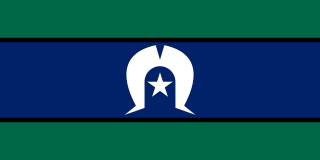
The Torres Strait Islands are an archipelago of at least 274 small islands in the Torres Strait, a waterway separating far northern continental Australia's Cape York Peninsula and the island of New Guinea. They span an area of 48,000 km2 (19,000 sq mi), but their total land area is 566 km2 (219 sq mi).

Torres Strait Islanders are the Indigenous Melanesian people of the Torres Strait Islands, which are part of the state of Queensland, Australia. Ethnically distinct from the Aboriginal peoples of the rest of Australia, they are often grouped with them as Indigenous Australians. Today there are many more Torres Strait Islander people living in mainland Australia than on the Islands.

Thursday Island, colloquially known as TI, or in the Kawrareg dialect, Waiben or Waibene, is an island of the Torres Strait Islands, an archipelago of at least 274 small islands in the Torres Strait. TI is located approximately 39 kilometres north of Cape York Peninsula in Far North Queensland, Australia.
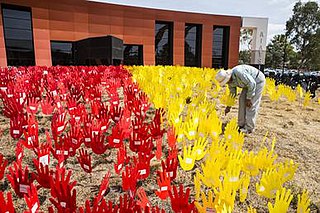
The Australian Institute of Aboriginal and Torres Strait Islander Studies (AIATSIS), established as the Australian Institute of Aboriginal Studies (AIAS) in 1964, is an independent Australian Government statutory authority. It is a collecting, publishing and research institute and is considered to be Australia's premier resource for information about the cultures and societies of Aboriginal and Torres Strait Islander peoples. The institute is a leader in ethical research and the handling of culturally sensitive material and holds in its collections many unique and irreplaceable items of cultural, historical and spiritual significance. The collection at AIATSIS has been built through over 50 years of research and engagement with Aboriginal and Torres Strait Islander communities and is now a source of language and culture revitalisation, native title research and family and community history. AIATSIS is located on Acton Peninsula in Canberra, Australian Capital Territory.
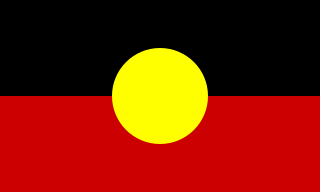
Aboriginal Australians are the various Indigenous peoples of the Australian mainland and many of its islands, but excluding the ethnically distinct people of the Torres Strait Islands. The term "Indigenous Australians" is applied to Aboriginal Australians and Torres Strait Islanders collectively.

The Shire of Torres is a local government area located in Far North Queensland, Australia, covering large sections of the Torres Strait Islands and the northern tip of Cape York Peninsula north of 11°S latitude. It holds two distinctions—it is the northernmost Local Government Area in Australia, and is the only one to abut an international border – it is at one point just 73 kilometres (45 mi) from Papua New Guinea. It is administered from Thursday Island.
Indigenous Australians are people with familial heritage from, or membership in the ethnic groups that lived in areas within the Australian continent before British colonisation, or both. They consist of two distinct groups: the Aboriginal peoples, who are many various peoples of the Australian mainland and Tasmania, and the Torres Strait Islanders, a Melanesian people from the seas between Queensland and Papua New Guinea. The term Aboriginal and Torres Strait Islander peoples or the person's specific cultural group, is often preferred, though the terms First Nations of Australia, First Peoples of Australia and First Australians are also increasingly common; 812,728 people self-identified as being of Aboriginal and/or Torres Strait Islander origin in the 2021 Australian Census, representing 3.2% of the total population of Australia. Of these Indigenous Australians, 91.4% identified as Aboriginal; 4.2% identified as Torres Strait Islander; while 4.4% identified with both groups. Since 1995, the Australian Aboriginal flag and the Torres Strait Islander flag have been official flags of Australia.

The Torres Strait Regional Authority is an Australian Government body established in 1994 to administer the Torres Strait Islands. It consists of 20 elected representatives. The primary function of the authority is to strengthen the economic, social and cultural development of the peoples of the Torres Strait area.
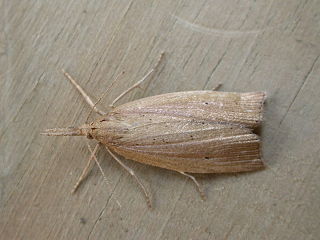
Chilo is a genus of moths of the family Crambidae. Some of these moths are called borers.

The Anglican Diocese of Carpentaria was an Anglican diocese in northern Australia from 1900 to 1996. It included most of northern Queensland, the islands of the Torres Strait and, until 1968, all of the Northern Territory. The see was based at Quetta Cathedral on Thursday Island in the Torres Strait.
Indigenous Australians are both convicted of crimes and imprisoned at a disproportionately higher rate in Australia, as well as being over-represented as victims of crime. As of September 2019, Aboriginal and Torres Strait Islander prisoners represented 28% of the total adult prisoner population, while accounting for 2% of the general adult population. Various explanations have been given for this over-representation, both historical and more recent. Federal and state governments and Indigenous groups have responded with various analyses, programs and measures.
Biri, also known as Biria, Birri Gubba, Birigaba, Wiri, Perembba and other variants, is an Australian Aboriginal language of the Mackay area of Queensland spoken by the Birri Gubba people. There are at least eight languages regarded as dialects of Biri, and two which are related but whose status is not yet fully determined. All are covered in this article.
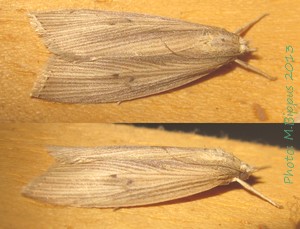
Chilo sacchariphagus, the spotted borer, is a moth of the family Crambidae. It was described by Wenceslas Bojer in 1856 and was originally found in South and South-East Asia, where there are three subspecies:

Kaurareg is the name for one of the Indigenous Australian groups collectively known as Torres Strait Islander peoples, although many or most identify as Aboriginal Australians. They are the traditional owners of Thursday Island (Waiben) as well as a number of Torres Strait Islands.
Chilo auricilius, the gold-fringed rice stemborer or terai borer, is a moth in the family Crambidae. It was described by Gerald C. Dudgeon in 1905. It is found in India, Taiwan, Bhutan and Sri Lanka, as well as on Sulawesi, Borneo, Sangir Island and the Moluccas. The larvae bore into and feed on the stems of various grass family plants including sugarcane, rice and maize.
Chilo infuscatellus, the yellow top borer or sugarcane shoot borer, is a moth in the family Crambidae. It was described by the Dutch entomologist Samuel Constantinus Snellen van Vollenhoven in 1890. It is found in India, Myanmar, Tajikistan, Afghanistan, Korea, Taiwan, Malaysia, the Philippines and on Java and Timor.
Bissetia steniellus is a moth in the family Crambidae. It was first described by the British entomologist George Hampson in 1899. It is found in India and Vietnam where it is commonly known as the Gurdaspur borer because the larvae bore their way into and feed on the stems of sugarcane.
Sturmiopsis inferens is a species of fly in the family Tachinidae. It is native to Asia and is a parasitoid of various moth species whose larvae feed inside the stems of sugarcane, rice and other large grasses, including the Gurdaspur borer and the sugarcane shoot borer.
The Unduyamo (Andooyomo) were an indigenous Australian people who once lived around the northern shore of Newcastle Bay, Cape York Peninsula Queensland. It has been hypothesized that, among other aspects of their life, they functioned as religious specialists for Torres Strait Islanders, whose mastery of increase rituals attracted the native mariners from the north. Together with the Gudang, who apparently spoke the same language and whose territory ran from Cape York to Fly Point opposite Pabaju, the Unduyamo had strong cultural, kin and trade ties with the Kaurareg, the southwestern islanders centered on Muralag, with whom they enjoyed an alliance that permitted reciprocal residence on each other's territory. All three groups regarded the Yadhaigana and Gumakudin as hostile.











